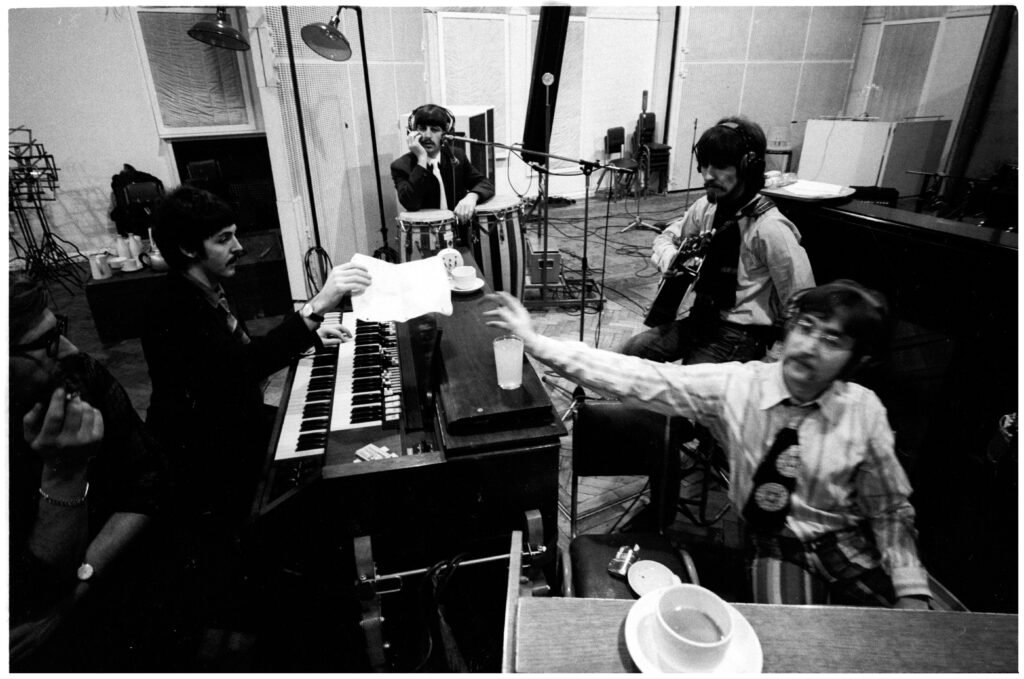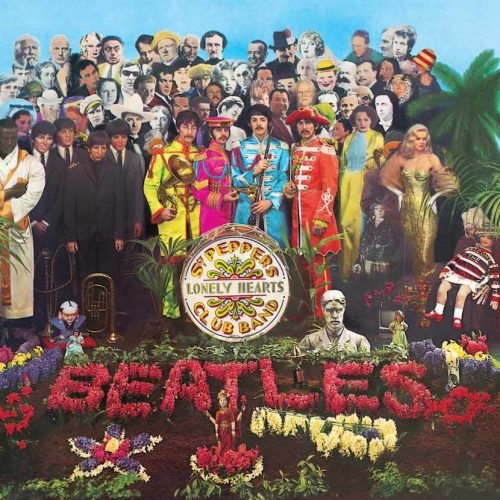In the pantheon of modern music, few albums have wielded as much influence or sparked as much conversation as The Beatles’ “Sgt. Pepper’s Lonely Hearts Club Band.” Released in 1967, amidst a tumultuous period marked by cultural shifts, political upheaval, and a burgeoning counter-culture movement, “Sgt. Pepper” stood as a beacon of innovation and artistic audacity. This album, arriving at the midpoint of The Beatles’ storied career, represented a seismic shift from their earlier work. Where once stood the lovable mop-tops from Liverpool, crooning about love and heartache, now stood avant-garde musicians pushing the boundaries of what popular music could be.
“Sgt. Pepper” was more than just an album; it was an immersive experience, a concept album that introduced listeners to the fictitious band named in the title. This artistic vision was a departure from The Beatles’ previous albums, which, while progressively more sophisticated and experimental, had largely adhered to the conventions of rock and pop music of the time. With “Sgt. Pepper,” The Beatles didn’t just deepen existing themes; they dove into uncharted waters, incorporating a vast array of instruments, recording techniques, and musical styles ranging from rock and roll to circus music, Indian ragas to traditional English vaudeville.
Artistic Intentions

The artistic intentions behind “Sgt. Pepper” were manifold, reflecting the complex interplay of influences and aspirations that The Beatles were navigating. Paul McCartney, who conceived the idea of the album, envisioned it as an opportunity for the band to experiment freely, liberated from the expectations tied to their global fame. This was a chance to redefine themselves and, by extension, the whole landscape of pop music. Interviews and album notes from the era reveal that The Beatles aimed to create a work that was both a reflection of the times and a step towards a future where music could convey profound, eclectic ideas with the same ease as pop songs spoke of love and longing.
I made a suggestion. I said, we need to get away from ourselves how about if we just become sort of an alter ego band.
Paul McCartney on the inception of Sgt. Peppers
In crafting “Sgt. Pepper,” The Beatles drew inspiration from a variety of sources, including the burgeoning psychedelic movement, classical music, and the studio-as-an-instrument concept pioneered by their producer, George Martin. The album’s cover, a colorful and intricate tableau featuring the band surrounded by a crowd of historical and contemporary figures, visually encapsulated the album’s exploratory spirit and its break from conventional rock aesthetics.
Sonic Exploration

The production quality of “Sgt. Pepper’s Lonely Hearts Club Band” is a masterclass in innovation and technical prowess, firmly situating it as a landmark achievement in recording history. Under the guidance of producer George Martin and engineer Geoff Emerick, The Beatles transcended conventional studio practices to create an album that was both sonically rich and meticulously crafted. The production is anything but lo-fi; each track is layered with crisp, clear soundscapes that were groundbreaking for their time. This clarity and attention to detail serve the album’s themes of exploration and fantasy perfectly, inviting listeners into the Sgt. Pepper universe with an immersive audio experience that was unprecedented in the late 1960s.
Musical Arrangements
Musical arrangements on the album are varied and complex, featuring an eclectic mix of instruments that were rarely heard in popular music at the time, including the Mellotron, sitar, and harpsichord, alongside traditional rock instruments. The use of orchestral elements, innovative recording techniques like automatic double tracking, and the integration of non-musical influences and sounds (such as circus music and everyday noises) contributed to a rich tapestry of sound that still feels innovative today. The album’s opening title track, followed by the seamless transition into “With a Little Help From My Friends,” showcases this innovative approach with its dynamic shifts in mood, instrumentation, and vocal arrangements, setting the stage for the rest of the album.
Perhaps the most memorable arrangement comes in “A Day in the Life,” which closes the album. The song features a 40-piece orchestra crescendo that blurs the lines between classical and pop music, creating an overwhelming sense of climax that has been described as an “orgasm of sound.” This piece, in particular, highlights The Beatles’ willingness to push musical boundaries and explore the limitless possibilities of studio recording.
Genre Elements
Genre elements within “Sgt. Pepper” are as diverse as the musical arrangements themselves, touching on rock, pop, psychedelia, classical, and music hall traditions. The album is a melting pot of genres, blending them in ways that had never been attempted before. “Lucy in the Sky with Diamonds” delves into psychedelic rock with its vivid imagery and dreamlike sounds, while “When I’m Sixty-Four” pays homage to the vaudeville music hall tradition, and “Within You Without You” incorporates Indian classical music, reflecting George Harrison’s deepening interest in the sitar and Eastern philosophies.
Lyrical Analysis

The lyrical landscape of “Sgt. Pepper’s Lonely Hearts Club Band” is as rich and varied as its musical composition, weaving together themes of love, loneliness, introspection, and the human condition with a narrative depth that is both reflective of its time and timeless. The central themes of the album reflect a departure from the more straightforward love songs that characterized The Beatles’ early work, delving into more complex, introspective, and sometimes whimsical territories.
Recurring Themes
One of the recurring motifs throughout “Sgt. Pepper” is the exploration of identity and the roles people play, both in their own lives and within society. This is introduced from the outset with the concept of the band taking on the alter ego of Sgt. Pepper’s Lonely Hearts Club Band, a device that allows them to explore various facets of human experience from a detached perspective. Songs like “With a Little Help From My Friends” and “Lucy in the Sky with Diamonds” offer glimpses into friendship, escape, and the search for meaning in an increasingly complex world, while “She’s Leaving Home” tells a poignant story of generational misunderstanding and the longing for independence.
Lyrical Depth
The lyrical depth of the album varies from the relatively straightforward narrative of “Being for the Benefit of Mr. Kite!” which was inspired by a 19th-century circus poster, to the abstract and surreal imagery found in “Lucy in the Sky with Diamonds.” The latter, with its vivid descriptions of kaleidoscopic landscapes and fantastical journeys, invites multiple interpretations, reflecting the band’s engagement with the psychedelic culture of the time. “A Day in the Life,” perhaps the album’s most complex lyrical undertaking, captures the banality and chaos of daily life through a collage of disconnected images and stories, culminating in an existential reflection on the nature of reality.
Emotional Impact
The emotional impact of the album’s lyrics is profound, evoking a spectrum of responses from joy and wonder to empathy and sadness. “When I’m Sixty-Four” offers a lighthearted take on aging and enduring love, while “She’s Leaving Home” and “A Day in the Life” touch on more somber themes, inviting contemplation on the costs of freedom and the pressures of societal expectations. The album’s exploration of these themes, combined with its musical innovations, creates a rich emotional tapestry that resonates with listeners on a deeply personal level.
Cohesion and Flow

In the realm of musical storytelling, “Sgt. Pepper’s Lonely Hearts Club Band” emerges not just as a collection of songs, but as a cohesive narrative journey, intricately woven with threads of thematic and emotional continuity. The Beatles, along with producer George Martin, meticulously crafted an album where each track flows into the next with purposeful intent, creating an immersive listening experience that transcends the sum of its parts.
From the moment the orchestra tunes up in the opening title track, introducing the fictional Sgt. Pepper’s band, to the reprise of the same song leading into the monumental “A Day in the Life,” the album maintains a narrative cohesion that is both remarkable and unique. The transition between songs is seamless, often blurring the lines where one ends and another begins, reinforcing the concept of the album as a singular, unified work. This sense of flow is not just a product of innovative studio techniques but a deliberate artistic choice that serves the album’s broader thematic exploration of identity, community, and the human experience.
Thematic Consistency
Thematic consistency is another pillar of “Sgt. Pepper’s” enduring legacy. Despite the diversity of musical styles and lyrical subjects, the album retains a sense of unity and purpose. Themes of love, longing, introspection, and the psychedelic experience recur, painted against the backdrop of the late 1960s counterculture. The Beatles manage to weave these varied threads into a coherent tapestry, with each song contributing to a larger narrative that reflects the complexities of modern life.
While the album is renowned for its adventurous sonic landscape, it’s the thematic resonance and emotional depth that anchor “Sgt. Pepper” in the listener’s consciousness. The joyous escapism of “Getting Better” and the nostalgic whimsy of “When I’m Sixty-Four” are balanced by the introspective melancholy of “She’s Leaving Home” and the existential musings of “A Day in the Life.” This emotional range, masterfully expressed through both music and lyrics, enhances the album’s narrative arc, guiding the listener through a spectrum of human experience.
Despite its eclectic mix of genres and styles, “Sgt. Pepper” never feels disjointed or jarring. Instead, the diversity of its musical and thematic elements serves to enrich the album’s narrative, making each transition feel like a natural progression in the story. The reprise of the opening title track towards the album’s end serves as a reminder of the journey the listener has undertaken, setting the stage for the climactic finale of “A Day in the Life” and reinforcing the album’s circular narrative structure.
Standout Tracks and Moments

Within the rich tapestry of “Sgt. Pepper’s Lonely Hearts Club Band,” certain tracks and moments shine with particular brilliance, capturing the essence of the album’s groundbreaking spirit and emotional depth. These standout elements not only highlight The Beatles’ artistic innovation but also underscore the album’s enduring legacy in the annals of music history.
Key Tracks
“Lucy in the Sky with Diamonds” stands out for its vivid imagery and dreamlike atmosphere. The song’s title, often associated with the psychedelic experience, introduces listeners to a fantastical world described in the lyrics. The use of surreal imagery, coupled with the ethereal Mellotron intro and the sitar’s subtle textures, showcases The Beatles’ experimental edge and willingness to explore new sonic landscapes.
“Within You Without You” is a testament to George Harrison’s deepening interest in Indian music and spirituality. The track is built around traditional Indian instruments, including the sitar, tabla, and tambura, creating a meditative and introspective ambiance. Its philosophical lyrics, exploring themes of unity and the interconnectedness of all things, set it apart as one of the album’s most spiritually profound offerings.
“A Day in the Life” is frequently cited as one of the greatest achievements in popular music. The song’s narrative, derived from daily news articles, transitions from mundane reality to introspective reflection, culminating in an orchestral crescendo of unparalleled intensity. The final, lingering piano chord serves as a powerful closing statement, leaving the listener in a state of awe and contemplation.
Memorable Moments:
The transition between the reprise of “Sgt. Pepper’s Lonely Hearts Club Band” and “A Day in the Life” is one of the album’s most seamless and impactful moments. This shift signifies the culmination of the journey through the album, preparing the listener for the grand finale.
The orchestral build-up in “A Day in the Life,” where a 40-piece orchestra was instructed to go from the lowest note their instruments could play to the highest in a chaotic crescendo, represents a defining moment of innovation and audacity. This crescendo, bridging two distinct sections of the song, is a sonic representation of the album’s thematic exploration of the boundary between the ordinary and the extraordinary.
The closing chord of “A Day in the Life,” a resonant E-major chord struck simultaneously on several pianos and allowed to ring out for over 40 seconds, stands as one of the most iconic endings in music history. The sustained note, gradually fading into silence, offers a moment of reflection and resolution, encapsulating the album’s introspective and transcendent qualities.
These standout tracks and moments are emblematic of “Sgt. Pepper’s” innovative spirit and emotional resonance. They illustrate The Beatles’ mastery over their craft, their ability to blend diverse musical styles, and their courage to delve into the depths of the human psyche. In doing so, “Sgt. Pepper’s Lonely Hearts Club Band” not only set new benchmarks for artistic achievement but also affirmed music’s power to inspire, challenge, and transform.
Artistic Contribution and Innovation
“Sgt. Pepper’s Lonely Hearts Club Band” stands as a monumental achievement in the music industry, marking a pivotal moment when the album transcended its status as merely a collection of songs to become a cohesive, unified piece of art. Its release in 1967 signaled a seismic shift not just within the rock genre, but across the musical spectrum and the cultural landscape at large. By shattering the conventions of popular music, The Beatles didn’t just push boundaries—they obliterated them, setting new standards for artistic expression and innovation in the process.
Boundary-Pushing in Genre and Industry
The album’s place within its genre is complex because it essentially created its own genre. Before “Sgt. Pepper,” few albums were conceived as a unified whole, with each song serving the larger narrative and thematic goals. This was a radical departure from the norm, influencing countless artists and bands to think of albums as comprehensive artistic statements. “Sgt. Pepper” also played a crucial role in the evolution of psychedelic rock, not just through its use of novel sounds and recording techniques but through its exploration of consciousness-expanding themes that mirrored the counterculture of the 1960s.
In the broader music industry, “Sgt. Pepper” challenged and changed the way albums were produced, marketed, and consumed. It demonstrated the potential of the studio as an instrument in its own right, a place where sounds could be manipulated and layered in service of artistic vision rather than simply captured. This approach has since become a staple in music production, but at the time, it was revolutionary.
Innovations in Production and Genre
The production techniques employed on “Sgt. Pepper” were groundbreaking. Producer George Martin and engineer Geoff Emerick leveraged the latest technology to experiment with effects such as phasing, artificial double tracking, and tape loops. The use of non-traditional instruments and sounds, including the sitar on “Within You Without You” and the harpsichord on “Fixing a Hole,” further expanded the sonic palette available to popular musicians. The orchestral crescendo in “A Day in the Life” is another example of the album’s innovative use of studio resources to create an unprecedented sound experience.
In terms of genre, “Sgt. Pepper” is remarkable for its eclectic diversity, seamlessly blending rock, pop, psychedelia, classical, and world music influences. This fusion not only blurred the lines between genres but also between Western and non-Western music, expanding the cultural horizons of listeners and musicians alike. The album’s approach to genre was not just innovative; it was transformative, encouraging a more inclusive understanding of musical expression.
Thematic Exploration
Thematically, “Sgt. Pepper” ventured into territories previously unexplored in pop music, dealing with concepts of identity, societal norms, and the human condition with a depth and complexity that was unheard of at the time. The concept of the album itself—a performance by the fictional Sgt. Pepper’s band—allowed The Beatles to explore these themes with a freedom and creativity that might have been impossible under their own identity. This innovative narrative technique has inspired countless artists to adopt alter egos or conceptual frameworks for their work, underscoring the album’s lasting impact on artistic storytelling.
Closing Thoughts

“Sgt. Pepper’s Lonely Hearts Club Band” is an album that defies simple analysis due to its complex layers of innovation, thematic depth, and musical experimentation. Its strengths are manifold, beginning with its pioneering production techniques, which expanded the horizons of what could be achieved in a recording studio. The Beatles, along with producer George Martin, crafted a sonic experience that was unparalleled at the time, employing novel recording methods and integrating a vast array of musical styles and instruments. This exploratory spirit is matched by the album’s ambitious thematic content, which delves into the realms of identity, society, and human consciousness with both whimsy and profound introspection.
The album’s approach to genre—blending rock, pop, psychedelia, classical music, and more—broke new ground in musical eclecticism, setting a precedent for future generations of artists. Moreover, “Sgt. Pepper” stands as a landmark in the concept album genre, with its cohesive narrative and thematic unity guiding listeners through a multifaceted auditory journey. The emotional impact of the album is significant, ranging from the joyous to the contemplative, and underscores The Beatles’ unparalleled ability to connect with the listener on a deeply personal level.
If there are weaknesses to be found in “Sgt. Pepper’s,” they might stem from its very ambition. Some critics have argued that certain tracks veer towards the self-indulgent or that the album’s eclectic nature occasionally lacks focus. However, these critiques are far outweighed by the album’s achievements and its profound influence on the music industry and popular culture at large.
The impact of “Sgt. Pepper’s Lonely Hearts Club Band” on listeners and its place in The Beatles’ career cannot be overstated. It marked a pivotal point where the band fully transitioned from pop icons to cultural revolutionaries, pushing the boundaries of music and artistry. The album not only captured the spirit of its era but also spoke to universal themes that continue to resonate with audiences today, ensuring its timeless appeal.
Official Rating
Given these considerations, “Sgt. Pepper’s” unequivocally deserves a rating of 10 out of 10. This score is a reflection of the album’s groundbreaking production, its innovative fusion of musical genres, and its profound thematic exploration, all of which combine to create a masterpiece of unparalleled artistic achievement. “Sgt. Pepper’s” is not just an album; it’s a landmark event in the history of music, setting standards that artists strive for to this day. Its perfect rating is a testament to its enduring significance, a beacon of creativity and innovation that continues to inspire and enchant listeners around the world.
